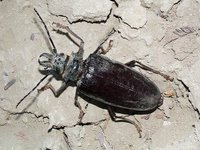 Here's a story about a unique cave ecosystem found in Israel that was completely cut off from the outside world, perhaps for millions of years. The large cavern system 300 feet below ground has an underground lake with 88 degree water. Some of the crustaceans found are related to saltwater species, others are related to fresh or brackish water species. Chemoautotrophic Bacteria form the underpinnings of the ecosystem. Most caves rely on nutrients brought in from the outside, much of it being organic material ultimately linked to the sun and photosynthesis.
Here's a story about a unique cave ecosystem found in Israel that was completely cut off from the outside world, perhaps for millions of years. The large cavern system 300 feet below ground has an underground lake with 88 degree water. Some of the crustaceans found are related to saltwater species, others are related to fresh or brackish water species. Chemoautotrophic Bacteria form the underpinnings of the ecosystem. Most caves rely on nutrients brought in from the outside, much of it being organic material ultimately linked to the sun and photosynthesis.Some related links:
Biospeleogy - The Biology of Cave, Karst and Groundwater
Article on protecting cave ecosystems - The US has the most cave dwelling species worldwide






